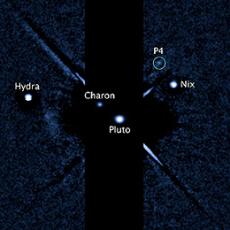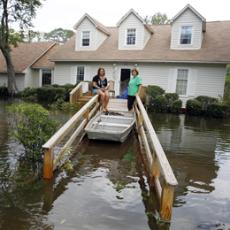JIM TEDDER: This is SCIENCE IN THE NEWS, in VOA Special English. I'm Jim Tedder.
KATHERINE COLE: And I'm Katherine Cole. Today, we tell about an ever increasing number of objects in low Earth orbit. We mark the 20th anniversary of the launching of the Hubble Space Telescope. We also tell how islands off the coast of North Carolina help to protect the rest of North America from destructive storms.
(MUSIC)
JIM TEDDER: A camera, a glove, a hand tool, even a toothbrush...they are all up there, above the clouds, going around and around the Earth. There are also thousands of pieces of metal and plastic. Some of them are only about the size of a fingernail. Many are much larger. Scientists consider all these objects to be "space junk," and they are a problem.
Since people first launched rockets into space in the 1950s, we have been leaving behind all sorts of things. Some of them, like the camera, were lost by astronauts while they did work outside their spacecraft. But much of the space junk is made up of little pieces of things that were once bigger objects, until they struck each other and broke apart.

KATHERINE COLE: Some things we send into space fall back toward Earth and burn up in the atmosphere. But larger pieces sometimes survive the extreme heat and hit the ground or the ocean at great speeds. So there is always concern that something may fall from the sky and do some harm.
But space junk falling on housetops is not the biggest worry. Scientists are concerned about the "Kessler" syndrome. It is named for the American scientist who first thought of the idea in 1978. Imagine what happens when an empty rocket strikes another while orbiting the earth. Two big things become many smaller things. They then hit other things. The pieces get smaller and smaller until they form a cloud of junk that blocks the path of future space vehicles.
JIM TEDDER: So what can be done to clean up the space around our planet? Marco Castronuovo, an Italian Space Agency researcher, has an idea. In the publication "Acta Astronautica," he writes about launching a satellite into space that would get very close to some of the larger pieces of space junk. The satellite would connect a small rocket to the useless object. When the rocket explodes, it pushes the junk into a lower and slower orbit, nearer the Earth. After a time, the junk burns up in the atmosphere.
Mr Castronuovo has proposed using a number of small satellites with robotic arms. One arm would catch the space junk, and another arm would connect the rocket. He imagines that each satellite would jump from one large piece of junk to another. He thinks this method could destroy about 10 large objects each year.
Scientists have been concerned about space junk for many years. Right now, the costs of the clean-up have been too great. Mr Castronuovo says his system could be put in place for a much more reasonable amount of money.
(MUSIC)
KATHERINE COLE: The Hubble Space Telescope continues to make valuable discoveries after more than 20 years in orbit around Earth. Hubble recently showed a fourth moon orbiting Pluto. Astronomers temporarily named it P4. The moon is the smallest to be discovered around the icy dwarf planet.

Astronomers estimate that the moon is from 13 to 34 kilometers across. They first saw it in a Hubble photo taken on June 28th.
The American space agency launched the Hubble Space Telescope in 1990. Reaching that day took years of work. Ed Weiler is the space agency's chief astronomer.
ED WEILER: "The Hubble, when it was launched, represented an increase in capability of other telescopes on the ground by a factor of 10. The last time in human history in astronomy that we leaped a factor of 10, in one step, was when Galileo stopped using his eye and put the first telescope to his eye."
JIM TEDDER: Nancy Grace Roman was the space agency's first chief of astronomy. She led the effort that led to the creation of the Hubble Space Telescope.
NANCY GRACE ROMAN: "Astronomers had been wanting to get observations from above the atmosphere for a long time. Looking through the atmosphere is somewhat like looking through a piece of old, stained glass. The glass has defects in it, so the image is blurred from that."
The Hubble telescope orbits about 550 kilometers above Earth. Ms Roman still remembers the first images that it captured.
NANCY GRACE ROMAN: "I think the image that to me was most striking was the center of a globular cluster. You could see each star individually, and see their color, and it was just a fantastic sight."
The Hubble Space Telescope has helped expand our knowledge of the universe. It helped scientists estimate that the universe began about 14 billion years ago. Ed Weiler says the telescope also confirmed the existence of black holes. These are extremely dense masses believed to exist at the center of most galaxies. Their gravitational pull is so strong, they absorb light.
The Hubble Space Telescope completed its one millionth scientific observation in July. The space agency is building a new space telescope to look even deeper into the beginnings of the universe.
(MUSIC)
KATHERINE COLE: On a large map of the United States, it looks almost like a mistake. But if you look closely enough you will see a number of small islands stretching into the Atlantic Ocean. The island chain is about 320 kilometers in length, and stretches mostly in a north to south direction.
This area is known as the Outer Banks of North Carolina. It is a land of "firsts." The first English settlers landed nearby on Roanoke Island in the late 1500s. This is where Virginia Dare was born. She was the first English child born in North America.
Three hundred years later, Wilbur and Orville Wright flew the first airplane with a motor at a place called Kill Devil Hills. And many, many times the Outer Banks has been the first place that large ocean storms ... hurricanes ... have begun their destruction.

JIM TEDDER: The Outer Banks are known as barrier islands. They are nothing more than long thin strips of sand that are separated from the mainland. To the right of the Outer Banks is the Atlantic Ocean. To the left are large waterways called sounds. In some places, the land is less than a kilometer wide, with water on both sides.
Because the Outer Banks stick so far out into the ocean, they are a windy place where storms often occur. Last month, Hurricane Irene moved through the Caribbean Sea and turned northward. The next land it touched was near Cape Lookout at the southern end of the Outer Banks. Over the next few days, the storm killed people, ruined homes and businesses, and flooded large parts of eastern North America.
KATHERINE COLE: Many scientists say that if Irene had not hit the Outer Banks first, the damage could have been worse for areas to the north. The Outer Banks was badly damaged. The main road near Cape Hatteras was washed away in at least two places, leaving many people unable to travel.
Hurricanes always do some damage to the Outer Banks. But this long, thin chain of sand also helps to take a lot of destructive energy out of the storms. When a hurricane hits land, it begins to lose strength since it no longer has the warm, wet air that it needs.
JIM TEDDER: Atlantic hurricanes often form far out at sea. Many begin as small storms off the west coast of Africa. As they move across the water, they move in a circle. They receive energy as they travel over warm water that has a temperature of at least 26 degrees Centigrade.
Scientists say a hurricane is like an engine that uses warm, wet air for fuel. Some hurricanes run out of warm water and fall apart at sea. Others continue to circle, getting stronger, and causing winds of nearly 200 kilometers an hour as they hit land.
KATHERINE COLE: Powerful storms have always been a part of the history of the Outer Banks. In 1586, the first English settlers in America were frightened by a terrible storm that lasted four days. Their leader, Sir Francis Drake, saw the hurricane destroy a number of his ships. In 1846, a huge storm washed completely over the land and formed inlets ... large openings between the sea and the sound.
Hurricanes have been known to hit the Outer Banks from May to December. But most of them arrive in August, September, and October. There is an old saying about the Outer Banks. "If you don't like the weather, just wait ten minutes."
(MUSIC)
This SCIENCE IN THE NEWS was written by Jim Tedder and June Simms, who was also our producer. I'm Katherine Cole.
JIM TEDDER: And I'm Jim Tedder. Listen again next week for more news about science in Special English on the Voice of America.
fingernail: a thin horny translucent plate covering part of the dorsal surface of the end joint of each finger 手指甲
space junk: the collection of objects in orbit around Earth that were created by humans but no longer serve any useful purpose 太空垃圾
"Kessler" syndrome: a scenario, proposed by NASA consultant Donald J. Kessler, involving space debris “凯斯勒症候群”,这个概念是美国宇航局顾问唐纳德·凯斯勒提出的,它设想有一天低地球轨道上的垃圾实在太多了,以至于人造卫星和航天器经常被撞击
Acta Astronautica: a journal publishes original contributions in all fields of basic, engineering, life and social space sciences and of space technology 《宇航学报》
(来源:VOA 编辑:张若琼)
